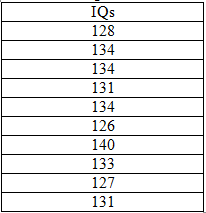One Sample T test
One-sample t test
This is used to compare the mean of one variable with a known or hypothesised value. In other words, the One-sample t tests procedure tests whether the mean of a single variable differs from a specified constant. For instance, you might be interested to test whether the average IQ of some 50 students differs from 125; or how the average salary in Newcastle compares to the national average.
Assumptions underlying the use of t test
Before we look at the details of how to perform and interpret a t test, it is good idea for you to understand the assumptions underlying the use of t test. The assumptions are:
- your data is normally distributed
- the variances between the groups are equal
- the sample size is adequate (at least 30 cases per group)
So, before you carry out any t test, you must check to make sure that your data satisfy all these assumptions. However, if your data seriously violates any of these assumptions then Non-parametric tests should be used. Non-parametric tests do not carry specific assumptions about population distributions, variance and sample size.
Exercise
Perform a One-sample t-test on the data on Table 1. Is the IQ of 10 students shown on the table different from an IQ of 125? This data file is stored in this location \\campus\software\dept\spss and is called iqs.sav.
Table 1: IQs of students

This test assumes that the data are normally distributed; however, this test is fairly robust to departures from normality. This probably explains why SPSS does not provide a non-parametric equivalent of this test. You have no option but to proceed with the parametric test.
Write down the null and alternative hypotheses for the One-sample t test:
Null Hypothesis (Ho): The IQ from the ten students is not different from an IQ of 125.
Alternative Hypothesis (H1): The IQ from the ten students is different from an IQ of 125.
One-Sample T Test
To do the actual test, follow these steps:
- From the menu bar select Analyze -> Compare Means -> One-Sample T Test….
- Select Intelligence Quotient [iq] and click on the arrow.
- Type 125 besides Test Value:.
- Click OK.
Use the output to answer these questions.
What is the average Intelligence Quotient [IQ] from the ten students? Is this average significantly different from an IQ of 125? Why? Will you accept or reject the null hypothesis? Why?
